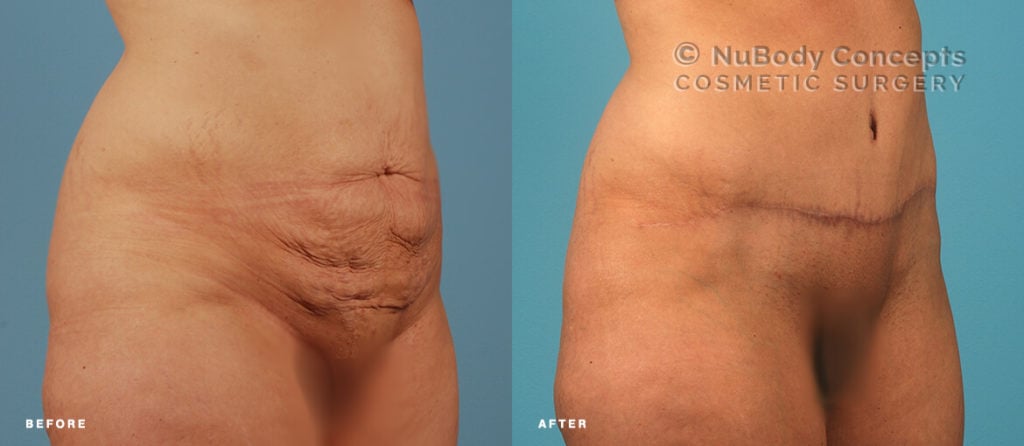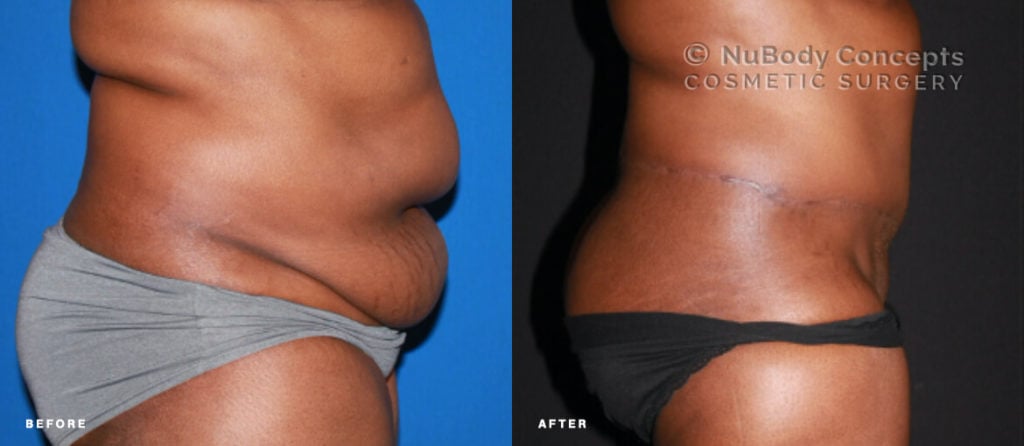
Medically reviewed by Dr. John Rosdeutscher – Written by Sine Thieme
Which Type of Tummy Tuck Should I Choose?
A tummy tuck – abdominoplasty – is a surgical procedure to remove excess skin and fat from the abdominal area to give the patient a flat, taut stomach. There are several different tummy tuck techniques to achieve this goal:
- Full or Classic Abdominoplasty
- Mini Abdominoplasty
- Extended Abdominoplasty
- Reverse Abdominoplasty
In addition, there are so-called non-surgical tummy tucks that use minimally-invasive skin tightening by means of radio frequency assisted lipolysis to achieve results similar to a tummy tuck, but without surgery.
Below we have outlined the different types of tummy tuck you might come across in your research. As always, make sure you schedule a consultation with a board-certified plastic surgeon to understand all your options and choose what’s best for you.
Full or Classic Abdominoplasty
A full abdominoplasty removes skin from above the navel down to the pubic region – often compromised by multiple pregnancies, genetic laxity, or obesity. For a full tummy tuck, the surgeon will typically make an incision around the belly button in addition to the “regular” horizontal incision in the lower belly area. The actual length of this incision could vary, ranging from 2-3 inches to the width of the entire abdomen. Any excess skin and fat are removed, the underlying muscle is repaired as needed (to address a common condition resulting from pregnancy called “diastasis recti”) , and the abdominal wall is tightened to finish it up.
In addition, the belly button is typically relocated with a full tummy tuck because otherwise it would end up much too low on your abdomen after all the skin has been removed. The plastic surgeon not only relocates the navel but also shapes it into an aesthetically pleasing slight oval shape – the centerpiece of your newly designed tummy.
In many cases, a standard or classic tummy tuck is also complemented with a round of liposuction to better shape the abdomen and ensure that the skin is tight in the adjacent areas. When all is said and done, a full abdominoplasty removes skin from above the navel all the way down to the pubic region. If you previously had a C-section, the scar can be hidden with tummy tuck surgery.

Mini Abdominoplasty
A mini abdominoplasty is less invasive than a full or classic tummy tuck. It typically only requires a single incision in the pubic region, lower down and shorter, meaning it is much more easily hidden below the bikini line. Just like with a standard tummy tuck, the surgeon will then remove the extra skin and use lipo as needed to help tone the area.
A mini tummy tuck is often all that is needed for patients who only have slight skin laxity below the navel, and/or a little protrusion or “pooch” that diet and exercise have failed to remove. However, similar outcomes may be achievable with radio frequency assisted lipolysis (more on that later), which is even less invasive than a mini abdominoplasty.
Extended Abdominoplasty (High Lateral Tension Tummy Tuck)
An extended or high lateral tension tummy tuck (often simply called extended tuck) extends the treated area all the way to above the hips and into the “love handle” region of the lower back. The incision typically ends up slightly longer and higher to achieve a fully flat abdomen. As with a full tummy tuck, your surgeon will incise below the navel to remove excess skin at the front of the abdomen and reposition and shape the belly button, often with supplementary liposuction to better contour the area.
The difference between an extended tuck and the other techniques is the lifting of skin above the hips – creating the high lateral tension of skin suggested in the name. Extended abdominoplasties are ideal for patients who have undergone drastic weight loss or have had multiple pregnancies. They typically require the longest recovery time of all tummy tucks due to the extended length of the scar.

Reverse Abdominoplasty
A reverse abdominoplasty, as the name suggests, reverses the direction of the tucking of skin. Instead of removing the skin below the navel and hiding the incision below the bikini line, a reverse tummy tuck removes skin just below the breasts via one long incision or two smaller ones underneath the breasts or even in the breast folds. The resulting scar(s) are easily hidden under a bra or bathing suit top.
Reverse abdominoplasties are ideal for patients who have a fairly toned lower abdomen but loose and flabby skin in the upper torso area. They can even be partnered with a mini tuck to completely revamp your midsection without the typical long scar across the midsection, and they can also be incorporated into any kind of breast enhancement surgery for a complete mommy makeover.
Do Tummy Tucks Work?
Any of these tummy tucks – standard tummy tuck, mini tuck, extended tummy tuck, reverse tummy tuck – are highly effective in getting you the flat stomach you desire. Which type of tummy tuck is best for you depends on the factors above and a discussion with your plastic surgeon. But no matter which method he or she uses, you will see an immediate and drastic difference – whether you struggle with post-pregnancy and childbirth fat you haven’t been able to get rid of, or have an excess of skin due to substantial weight loss or age-related skin laxity.
For patients who do not mind the invasive nature of a tummy tuck, the resulting scar, and the longer recovery, a tummy tuck is the most effective cosmetic surgery to achieve the desired results.
Non-Surgical Abdominoplasty
As mentioned above, non-surgical tummy tucks aren’t really tummy tucks at all as they do not involve the typical incisions of surgery. However, technological breakthroughs in recent years have given surgeons new tools to achieve better and better outcomes using radio frequency or ultrasound energy. These procedures are similar to liposuction whereby the doctor inserts a thin wand under the skin through minuscule incisions to target fatty tissues under the skin. They typically do not require sedation and can be administered under local anesthesia.
This type of radio frequency or ultrasound assisted liposuction is often summarized under “skin tightening.” In the past, a surgeon couldn’t come close to getting the kinds of results anywhere close to a tummy tuck using only skin tightening. But the latest technologies such as BodyTite and Renuvion can achieve skin contraction from 35% to 60%, thereby allowing patients to forego a surgical tummy tuck altogether. It’s a great alternative for someone who has only slight skin laxity, wants a fast recovery, and wishes to avoid a scar.
We hope we’ve given you a comprehensive understanding of the various types of tummy tuck. Please feel free to get in touch with us if you have any other questions.
If you are ready to get started, use the pink button to schedule a consultation with our board-certified plastic surgeon in Nashville or Memphis.















